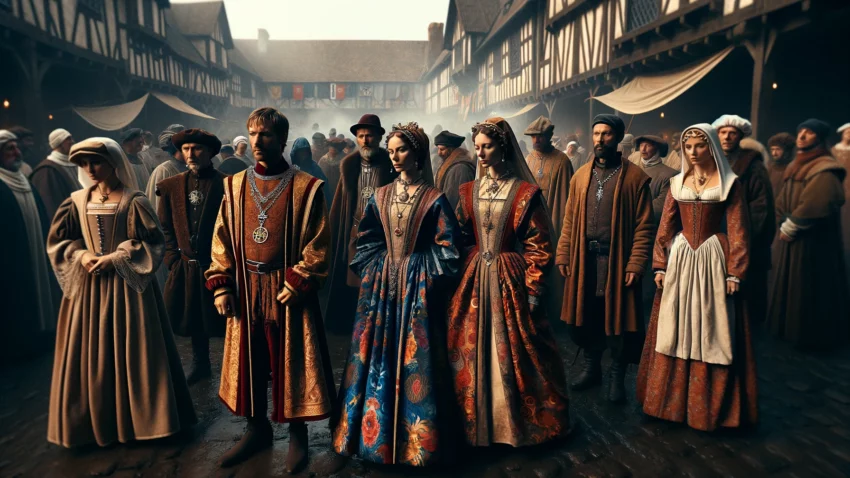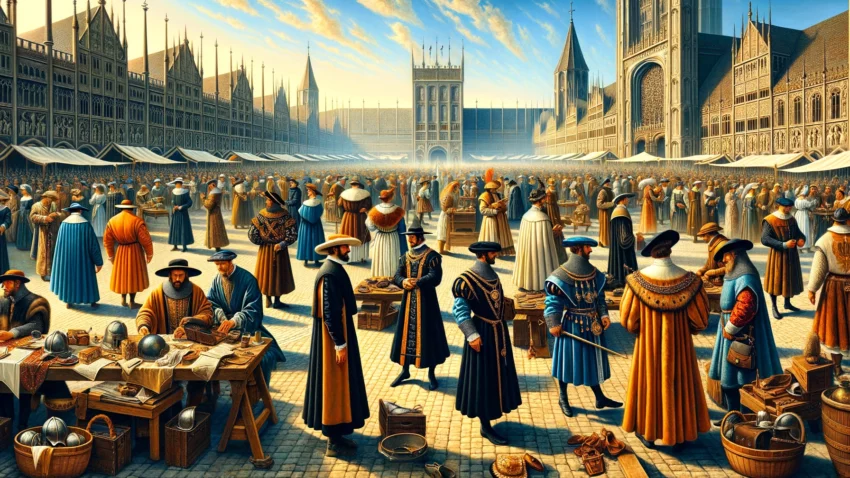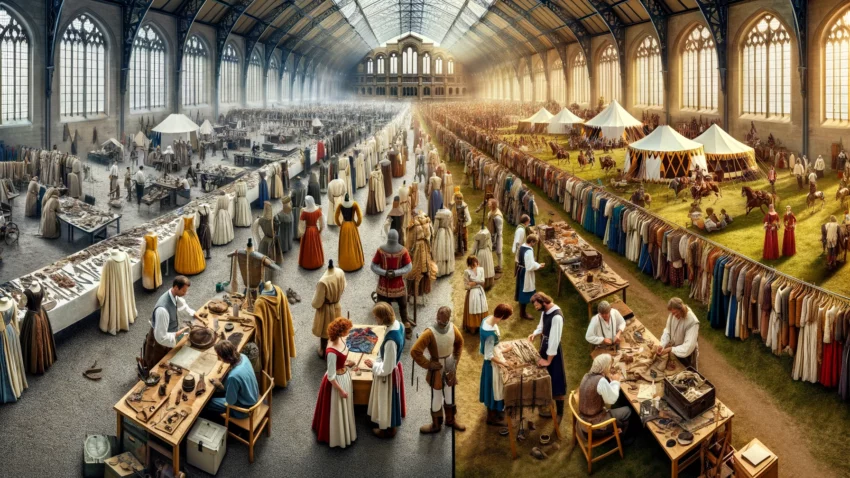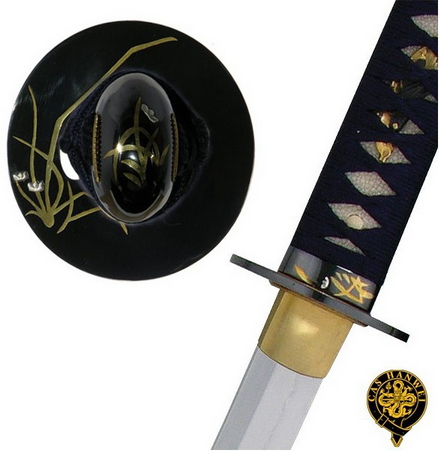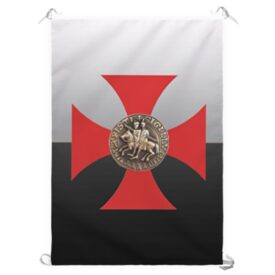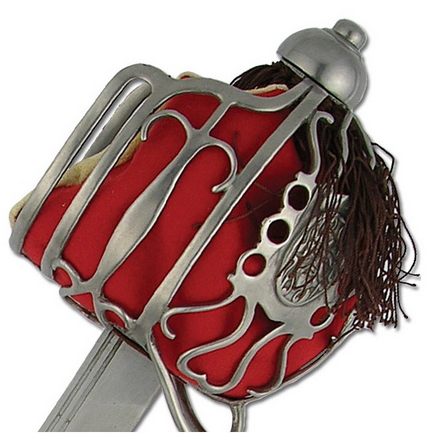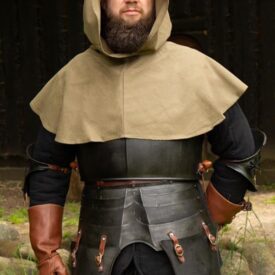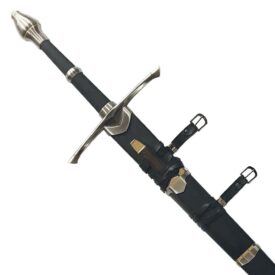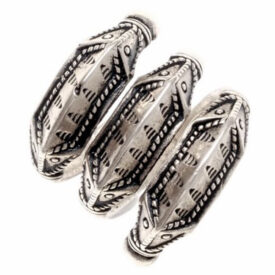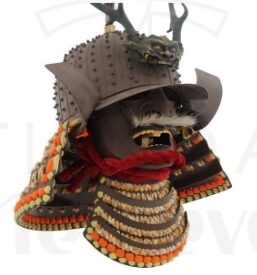Immerse yourself in the fascinating world of medieval costumes, exploring their diversity, materials, and the cultural influence they have had throughout history and today.
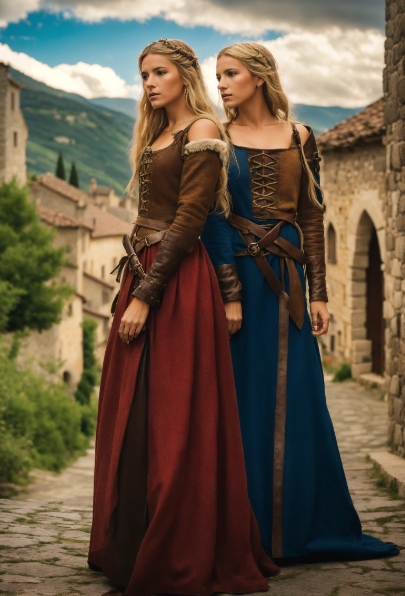
The Middle Ages, a historical period spanning from the 5th to the 15th century, is remembered not only for its conflicts and social changes but also for its rich clothing. Medieval costumes were not merely garments; they were an expression of status, profession, and regional identity, reflecting the complexity of a stratified society. This article will guide you through the evolution of medieval fashion, highlighting its significance and legacy today.
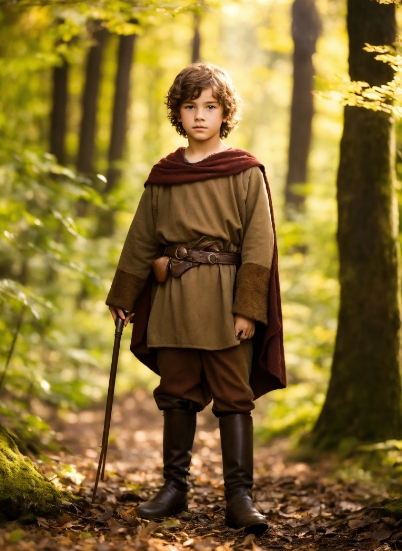
Introduction to Medieval Costumes
Medieval clothing was influenced by numerous factors, including geography, climate, available materials, and, above all, social status. The diversity in clothing was notable, from the humble fabrics of peasants to the luxurious silks and velvets of the nobility.
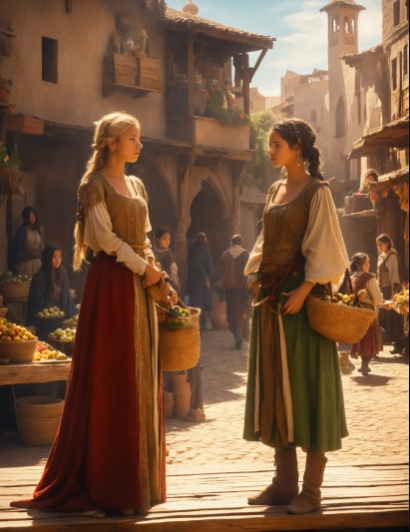
- Historical context: The Middle Ages, which roughly spanned from the 5th to the 15th century, was a period of great social, political, and cultural transformations in Europe. During this era, clothing not only served a practical function of protection and warmth but also served as an important indicator of social status, profession, and regional identity. Medieval costumes varied greatly in terms of materials, colors, and designs, reflecting the social stratification and geographical differences of the time.
- Cultural and social significance: Medieval clothing held profound cultural and social significance. The colors, materials, and style of a garment could convey much information about the individual wearing it, from their social and economic status to their occupation and even their moral standing according to the norms of the time. The Church, nobility, and guilds of artisans exerted a significant influence on fashion, dictating trends and establishing norms about what could be worn and by whom, thus reinforcing social hierarchies and roles within medieval society.
Diversity of Costumes in the Middle Ages
The social stratification of the Middle Ages was clearly reflected in clothing. The nobility wore fine fabrics and vibrant colors, while peasants wore more functional garments made of sturdy materials. Regional differences also played an important role, giving rise to a rich variety of styles across Europe.
- Costumes according to social class: Clothing in the Middle Ages varied considerably according to the individual’s social class. The nobility could afford clothing made of imported fine fabrics, such as silk, adorned with furs, jewels, and intricate embroidery. In contrast, the working classes wore simpler and more functional garments made of wool or linen, which were durable and suitable for daily work. This contrast in clothing emphasized social divisions and helped maintain the established order.
- Regional differences: Climatic and cultural differences across Europe also influenced medieval fashion. In the colder regions of the north, garments were heavier and more functional, designed to provide warmth. In the south, where temperatures were warmer, fabrics were lighter, and garments were looser. Additionally, cultural influences from neighbors and invaders, such as the Moors in Spain, introduced unique elements into local fashion.
Materials and Tailoring Techniques
The materials used to make medieval costumes varied widely, from wool to linen and silk, each chosen for its availability, cost, and status. Tailoring techniques were equally varied, reflecting the ingenuity and creativity of craftsmen of the time.
- Fabrics and materials used: The availability of materials varied significantly from one region to another, directly influencing the types of garments produced. Wool was the most common material, used in a variety of qualities depending on the wealth of the wearer. Linen was used for underwear and summer garments, while silk, much more expensive, was reserved for the high society. Leather was also used for shoes, belts, and some outer garments.
- Tailoring methods: Making medieval garments was a laborious process that required specialized skills. Before the invention of the sewing machine, all clothing was made by hand, making garments expensive and valued. Tailors and seamstresses followed traditional techniques, passed down from generation to generation, to create everything from simple tunics to complex ceremonial attire. The decoration of garments was also important, with techniques such as embroidery, weaving, and quilting adding beauty and value to the garments.
Female Medieval Costumes
Medieval women’s clothing was both functional and decorative, with great attention to detail in embroidery and accessories. From the simple dresses of peasant women to the elaborate attire of the nobility, each garment told a story.
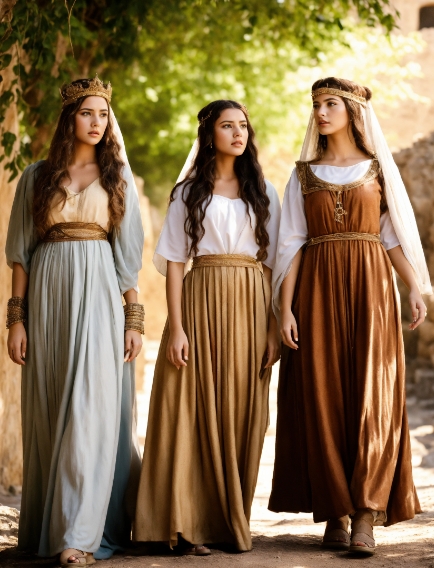
- Everyday and ceremonial attire: Medieval women’s clothing varied widely depending on the occasion. For everyday wear, women of all social classes wore simple tunics that reached the ground, often with a belt at the waist. For special events or ceremonies, noblewomen wore more elaborate and ornamented dresses, made of precious fabrics and adorned with embroidery, pearls, and gemstones. The difference in clothing between everyday life and formal occasions was pronounced, reflecting the status and wealth of the wearer.
- Accessories and complements: Accessories were an essential part of medieval women’s fashion, both for functionality and aesthetics. Hats and headdresses ranged from simple veils and caps to elaborate structures covered in fabric, indicating the woman’s social and marital status. Belts, often decorated with jewels or precious metals, served to adjust garments and as attachment points for bags, keys, and other personal items. Jewelry, such as rings, brooches, and necklaces, added a touch of distinction and were especially popular among the upper classes.
Male Medieval Costumes
Similar to women’s fashion, men’s clothing varied according to status and occupation. Noblemen wore complex and ornate outfits, while workers’ clothing was much simpler and practical.
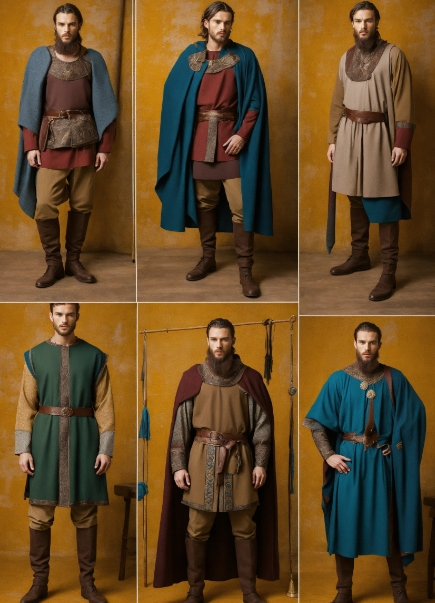
- Everyday and ceremonial attire: Like women’s fashion, medieval men’s clothing depended on the occasion. For daily work, men wore hose (predecessors of pants) and short tunics. For formal or ceremonial occasions, noblemen wore long and rich tunics, often with layers over them. The materials and decoration of these outfits reflected the individual’s rank and wealth, with the nobility preferring imported fabrics and luxurious adornments.
- Accessories and armor: Men also used a variety of accessories, including belts for hanging swords and other weapons, bags, and hats. Armor was another important element of male clothing in the nobility, especially for those involved in combat or tournaments. From chainmail to silvered armor, these elements not only served for protection but also as symbols of power and status.
Influence of the Church and Nobility
The Church and nobility not only dictated etiquette rules but also fashion trends. Dress restrictions aimed to maintain social order, while the colors and symbols used in clothing often had specific meanings.
- Dress restrictions and regulations: The Church and nobility played crucial roles in dictating dress codes during the Middle Ages. Sumptuary laws were enacted to limit luxury in clothing and ensure that each social class was easily identifiable by their attire. These laws restricted the use of certain fabrics, colors, and decorations to the nobility and royalty, in an attempt to keep the social hierarchy visible and reinforced.
- Representative symbols and colors: The colors and symbols used in medieval clothing often had specific meanings and were used to communicate messages about the wearer. Purple, for example, was reserved for royalty and the high nobility, symbolizing power and wealth. Religious symbols, such as crosses and saints, were common in the clothing of clerics and those associated with the Church, reflecting their devotion and role in society.
Events and Festivities: Special Costumes
During tournaments, religious celebrations, and festivities, special costumes were worn that stood out for their extravagance and beauty. These events offered the opportunity to display wealth and good taste through fashion.
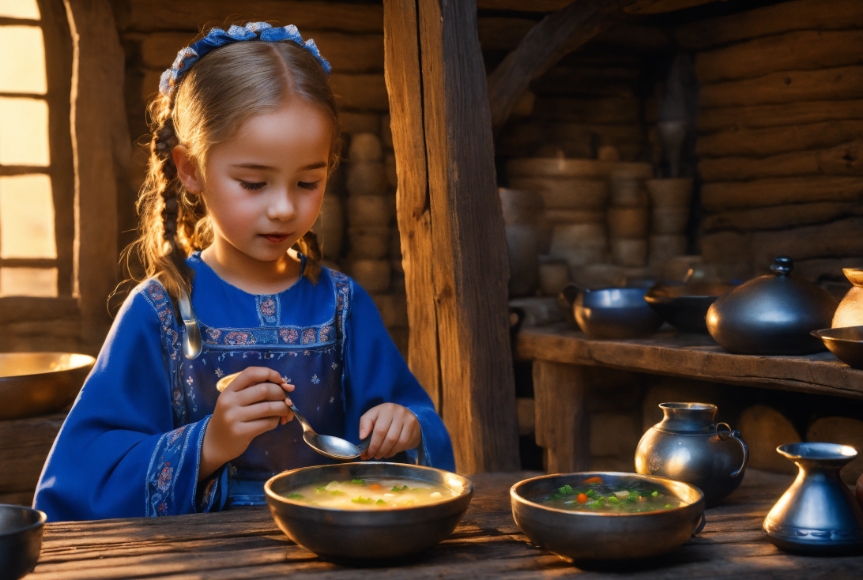
- Costumes for tournaments and celebrations: During tournaments, weddings, and other major celebrations, both men and women were expected to wear their most impressive outfits. Tournament participants often wore elaborately decorated armor, while court ladies adorned themselves with their finest dresses and jewelry. These events were opportunities to display wealth, taste, and social prestige.
- Religious and ritual garments: Religious festivities also required special clothing. Clergy and members of religious orders wore ceremonial robes that varied depending on the occasion and rank within the Church. During processions and religious rituals, the community could wear special clothing to reflect the solemnity of the event, often in colors and styles prescribed by tradition or ecclesiastical law.
Conservation and Replicas of Medieval Costumes
Today, museums and collectors work diligently on the conservation of medieval costumes, while enthusiasts recreate detailed replicas for events and fairs, keeping history alive.
- Museums and collections: The conservation of medieval costumes is a crucial aspect of understanding the history and culture of this period. Museums around the world house collections of clothing dating from the Middle Ages, carefully preserved for the education and enjoyment of future generations. These pieces offer an invaluable window into the past, allowing historians and the general public to appreciate the tailoring techniques, materials used, and fashion trends of the time.
- Creation of replicas and their current relevance: The creation of replicas of medieval costumes plays an important role in historical education and cultural recreation. Artists and craftsmen specializing in fashion history use traditional techniques and authentic materials to recreate garments that are almost indistinguishable from the originals. These replicas are used not only in movies and theatrical productions to add authenticity to historical representations but also in medieval fairs and historical reenactment events, allowing people to experience firsthand the clothing and life of the Middle Ages.
“Medieval Costumes” in Popular Culture
The fascination with medieval fashion transcends the historical realm, influencing film, literature, and theater, and generating ongoing interest in fairs and festivals that celebrate this rich cultural heritage.
- Influence on film, literature, and theater: The fascination with the Middle Ages and its costumes is widely reflected in contemporary popular culture. Movies, television series, plays, and books often draw inspiration from medieval aesthetics to create rich and visually stunning worlds that capture the imagination of the audience. This influence not only revives interest in medieval history and fashion but also introduces a modern interpretation of these elements, adapting them to current aesthetic sensibilities and preferences.
- Medieval festivals and fairs: Medieval festivals and fairs are popular events that celebrate the history and culture of the Middle Ages, attracting people of all ages and backgrounds. At these events, participants often dress in medieval costumes, engage in activities such as jousting, banquets, and craft workshops, and enjoy entertainments such as music and theater from the period. These celebrations not only offer fun and education but also provide a community for those interested in medieval history and historical reenactment.
Interesting Questions and Answers
How did social status determine clothing in the Middle Ages?
Social status in the Middle Ages had a direct impact on people’s clothing. The nobility and royalty could afford high-quality fabrics, such as silk and velvet, and their outfits were often adorned with embroidery, fur, and jewels. In contrast, the working classes wore garments made of cheaper and more durable materials, such as wool and linen. Sumptuary laws, which regulated the type of clothing each social class could wear, also reinforced these differences, limiting the use of certain colors, fabrics, and decorations to the upper strata of society.
What materials were most commonly used in the making of medieval costumes?
The most common materials in the making of medieval costumes included wool, linen, and for the fortunate, silk. Wool was especially popular due to its availability and versatility, and could be woven into various degrees of fineness for different purposes. Linen, frequently used for underwear and summer garments, was valued for its coolness and ease of laundering. Silk, a luxury material imported from the East, was primarily reserved for the high nobility and royalty.
Were there significant differences in fashion across different regions of Europe?
Yes, there were significant differences in fashion across different regions of Europe during the Middle Ages. These variations were the result of factors such as climate, local economy, available material resources, and the cultural influence of neighbors or conquerors. For example, in northern Europe, where the climate was colder, preference was given to heavy woolen garments and layers. In contrast, in southern Europe, fabrics were lighter, adapting to warmer climates.
How have medieval costumes influenced contemporary fashion?
Medieval costumes have influenced contemporary fashion in various ways, inspiring both haute couture designers and everyday fashion. Elements such as puffed sleeves, fitted bodices, and flowing silhouettes have been reinterpreted in modern collections. Additionally, fascination with the medieval period has led to the popularity of fantasy-inspired fashion, especially in the context of festivals and themed events.
Where can I see authentic medieval costumes today?
Authentic medieval costumes can be seen in various museums around the world. Institutions such as The Metropolitan Museum of Art in New York, the Victoria and Albert Museum in London, and the Musée de Cluny in Paris have impressive collections of medieval textiles and clothing. These museums offer a window to the past, allowing visitors to appreciate the complexity and beauty of medieval fashion.
How are replicas of medieval costumes created for festivals and events?
Replicas of medieval costumes for festivals and events are created through a detailed process of research and craftsmanship. Replica creators study historical references, such as illuminated manuscripts, paintings, and the few garments that have survived to this day, to ensure that their reproductions are as faithful as possible to the original. They use traditional tailoring techniques and seek out fabrics that resemble those used in the Middle Ages, striving to capture the essence of the era in every detail of their creations.
Exploring medieval costumes is immersing oneself in a world of color, texture, and meaning, where each garment tells the story of an era defined by its rigid social structures and rich cultural diversity. Through the conservation and recreation of these costumes, we keep alive the legacy of a fascinating past, allowing us to appreciate the complexity and beauty of medieval fashion.
